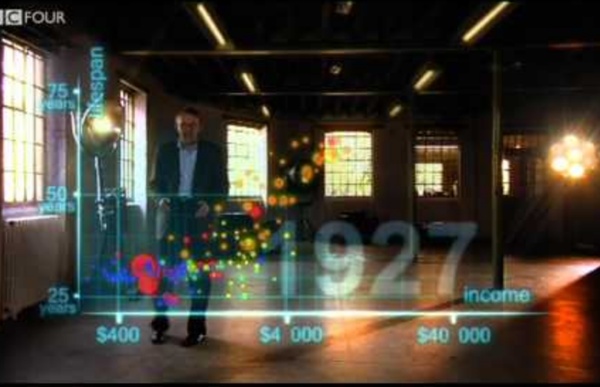



http://www.youtube.com/watch?v=jbkSRLYSojo
Related: the wow!/ouch! factor • Présenter des données • Visualization • The World is Getting Better25 Superb Optical Illusions For Kids An optical illusion (also called a visual illusion) is characterized by visually perceived images that differ from objective reality. The information gathered by the eye is processed in the brain to give a perception that does not tally with a physical measurement of the stimulus source. There are three main types: literal optical illusions that create images that are different from the objects that make them, physiological ones that are the effects on the eyes and brain of excessive stimulation of a specific type (brightness, color, size, position, tilt, movement), and cognitive illusions, the result of unconscious inferences. Source Wikipedia. These optical illusions for kids help them in increasing concentration power and sharpen their focus. Though these optical illusions are for kids, we are sure that adults will enjoy them, as well.
Vérifier son site pour les daltoniens >>> Toptal Color Blind Filter Use the Colorblind Colorlab to select safe colors earlier in the design process. Learn more about colorblindness in this Wikipedia entry. This tool is still in development, but feedback is welcome while we work on it. If you only use one filter, use the greyscale filter which will not only point out potential problem areas, but will also let you see more clearly which areas the filter is unable to process. Improvements We have made the following improvements to the colorblind web page filter.
The true colors of Yellowstone’s Thermal Springs unveiled by scientists Published time: December 21, 2014 22:38 Yellowstone National Park, Wyoming (Reuters) Researchers have created a simple mathematical model that reveals the stunning colors of the hot springs at Yellowstone National Park by visually recreating what they looked like years ago before decades of tourists ruined them with rubbish. Tracking Social Media Events and Logged-In Users in Google Analytics with Universal Analytics There was a great post on Technical Marketing about tracking social media events and logged-in users in Google Analytics using the new Universal Analytics. I would like to elaborate on the instructions to make it even easier to set up and get tracking. The following examples use a combination of JavaScript and jQuery. It is possible for these techniques to be used without jQuery, but some code re-factoring would need to be done. Note that the below snippets will be designated as HTML even though they are primarily JavaScript because they should be placed into <script> tags within your HTML files.
The Limitations of QALY: A Literature Review Pettitt DA1,2*, Raza S3, Naughton B3,8,9, Roscoe A3, Ramakrishnan A3, Ali A3, Davies B1,4, Dopson S3, Hollander G2,10, Smith JA1,4 and Brindley DA1-3,5-7 1The Oxford – UCL Centre for the Advancement of Sustainable Medical Innovation (CASMI), The University of Oxford, New Richards Building, Old Road Campus, Oxford, OX3 7LG, UK 2Department of Paediatrics, University of Oxford, Children's Hospital, John Radcliffe, Oxford, OX3 9DU, UK 3Said Business School, University of Oxford, Park End Street, Oxford, UK 4Nuffield Department of Orthopaedics, Rheumatology and Musculoskeletal Sciences, University of Oxford, Old Road, Oxford, OX3 7LD, UK 5Centre for Behavioural Medicine, UCL School of Pharmacy, University College London, BMA House, Tavistock Square, London WC1H 9JP, UK
Paula Zuccotti documents the things people touch in a day. Paula Zuccotti How many things do you touch in one minute? How about an hour? Paula Zuccotti asked people of different ages and backgrounds all over the world to make note of how many objects they touch during a day for her series “Every Thing We Touch.” The photos were turned into a book that was published this past December. Zuccotti—a designer and trends forecaster who founded the Overworld, a consultancy agency that specializes on the interaction between culture and technology—was curious to learn more about how our daily interactions come to define ourselves and what she might be able to learn about the things we “need, appreciate, consume, or simply touch.”
Respecter les ratios >>> Misleading graph Graph that misrepresents data In statistics, a misleading graph, also known as a distorted graph, is a graph that misrepresents data, constituting a misuse of statistics and with the result that an incorrect conclusion may be derived from it. Graphs may be misleading through being excessively complex or poorly constructed. Yellowstone's Thermal Springs Printer friendly version Share 19 December 2014 American Institute of Physics (AIP)
8 advanced Segments for Google Analytics from 8 experts. Check it out When you need insights from your analytics data, some of the most powerful is to segment the data. Advanced segments in Google Analytics gives you all you need. I have the impression that just a small percentage of the Google Analytics users actually uses this strong feature, so I want to show all of you how it can be used. In January I had the pleasure of presenting to SuperWeek conference in Hungary. Pricing and Paying for Cures: Early Experience with HTA of Gene Therapy in the USA In a new OHE Seminar Briefing, Dr Steven Pearson, President of the Institute for Clinical and Economic Review (ICER), discusses early experiences of using HTA to assess Gene Therapy, setting out four challenges. First, uncertainty about clinical effectiveness makes it difficult for ICER to suggest an appropriate price. Pilot projects with some gene therapies involve five years of instalment payments.